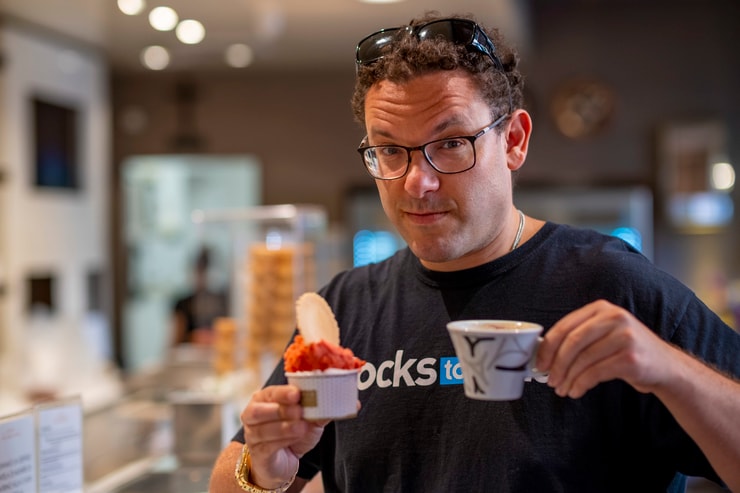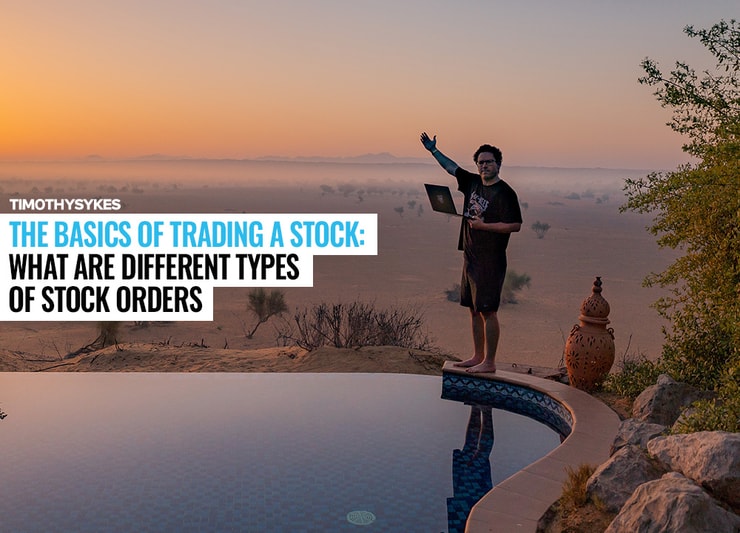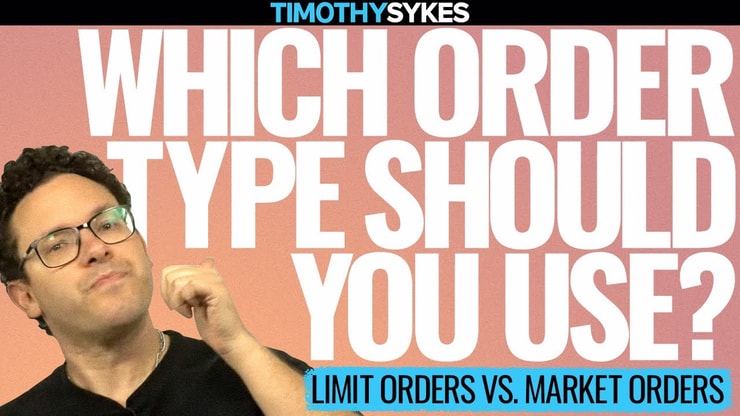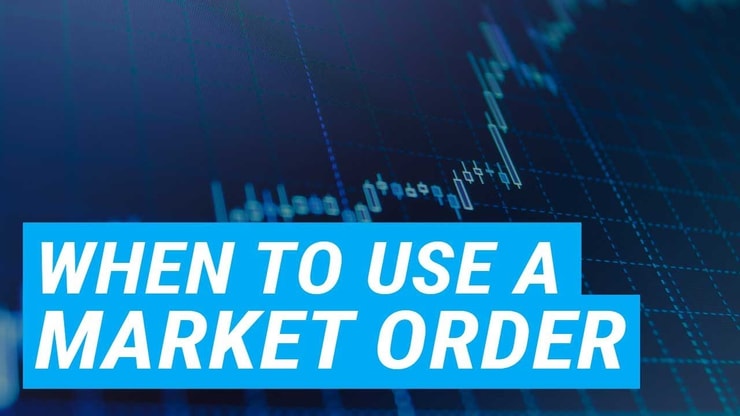One of the key decisions you’ll make as a trader is which of the different types of stock orders you should use.
It’s not as straightforward as just clicking ‘buy’ or ‘sell’. There’s a wide array of stock orders, each with its own purpose and strategy (and fees!). Mastering all of this information is a crucial step in becoming a successful trader.
I’ve been teaching for over a decade, and this is one of the questions I get most often. In my experience, the answer is different for every case, as well as the assets you’re trading.
Ready to dive in? Let’s get started.
Table of Contents
What Are Stock Orders?

2025 Millionaire Media, LLCStock orders are instructions that traders give to their brokers as buyers or sellers of securities. They’re like your trading playbook, deploying different moves based on market conditions and trading strategies.
As we delve into the world of stock orders, it’s crucial to have a solid grasp of trading terms. Understanding the language of trading can significantly enhance your ability to navigate the market and make informed decisions. For a comprehensive guide on trading terms, consider exploring this resource. It’s a valuable tool for both beginners and seasoned traders looking to refresh their knowledge.
Different Types of Stock Orders
There are several types of stock orders, each serving a different purpose. Market orders, limit orders, stop orders, and stop-limit orders are some of the most common ones. But there are also more advanced order types like trailing stop orders, fill-or-kill orders, and good ’til canceled orders.
Understanding these order types is crucial to executing your trading strategy effectively. Stocks, options, ETFs, and other investment products will all call for their own order strategy.
For example, most mutual funds trade once per day. They appeal more to investors than traders, and they don’t require the same order type strategies as stock trading…
But you still want to know when your money leaves your account!
Day trading, in particular, requires a broader understanding of various factors, including market trends, risk management, and trading psychology.
To gain a more holistic view of day trading, check out this guide on day trading basics. It provides a comprehensive overview that can help you navigate the day trading landscape more effectively.
Limit Price
A limit price is a predetermined price point set by a trader for a specific stock order. It’s the price at which a trader is willing to buy or sell a stock. Setting a limit price allows traders to have control over the execution price of their trades, ensuring that they don’t pay more or sell for less than they’re comfortable with.
Utilizing a limit price is a strategic move that can help traders optimize their profits and limit their losses. It’s a way of saying, “This is the price I’m willing to trade at, and not a penny more or less.”
This is very important for traders.
However, it’s important to remember that while a limit price gives you control over the trading price, it doesn’t guarantee that the order will be executed, especially in fast-moving markets where prices can change rapidly.
What Is a Limit Price?
A limit price is the specific price at which you want to buy or sell a stock. It’s like setting a target in your trading strategy. When you place a limit order, the trade will only be executed if the stock reaches your specified limit price.
Benefits of Using a Limit Price
Using a limit price gives you control over the price at which you buy or sell a stock. It can help you buy a stock at a lower price or sell it at a higher price than the current market price. But remember, there’s no guarantee that the stock will reach your limit price, so your order may not be executed.
Current Market Price

2025 Millionaire Media, LLCThe current market price is the live price at which a stock is trading on the exchange. It’s the price that you see flashing on your trading screen, constantly changing due to the dynamic nature of the market. The current market price is determined by the equilibrium between supply and demand for the stock in the market.
Understanding the current market price is crucial for traders as it serves as the benchmark for making trading decisions. It’s the price at which market orders are executed and serves as a reference point for setting limit orders and stop orders. However, it’s important to remember that the current market price is a snapshot in time and can change rapidly due to a variety of factors, including changes in market sentiment, news events, and trading volumes. Therefore, while the current market price is an important tool in a trader’s arsenal, it should be used in conjunction with other market indicators and trading tools to make informed trading decisions.
More Breaking News
- ATRO Stocks Fly High: Ready for Takeoff?
- Kratos Defense Gains as Analysts Show Strong Optimism
- CLSK Shares Plummet: Is It Time To Exit?
What Is the Current Market Price?
The current market price is the price at which a stock is currently trading in the market. It’s like the going rate for a stock, constantly changing based on supply and demand.
This is different from a ‘market order’ — which is basically when you say, “I’ll make the deal at whatever price you think is fair!
If my two decades of trading experience means anything to you, you’ll pay attention to the advice in this video:
Factors that Affect the Current Market Price
Several factors can affect the current market price of a stock, including the company’s financial performance, market conditions, and economic events. As an investor, it’s important to keep an eye on these factors to make informed trading decisions.
How to Check Current Market Prices
You can check the current market prices of stocks on financial news websites, stock market apps, or your broker’s trading platform. These platforms provide real-time price updates, helping you stay on top of market trends.
Sell Limit Order

2025 Millionaire Media, LLCA sell limit order is a type of order that instructs a broker to sell a stock once it reaches a specific price or higher. It’s a strategic move used by traders who anticipate that a stock’s price will rise before it starts to fall. By setting a sell limit order, traders can ensure that they sell the stock at an optimal price.
However, while a sell limit order can help traders maximize their profits, it also comes with risks. The primary risk is that the stock’s price may never reach the limit price, resulting in the order not being executed. Therefore, while sell limit orders can be a powerful tool in a trader’s arsenal, they should be used judiciously and in line with a well-thought-out trading strategy.
What Is a Sell Limit Order?
A sell limit order is an order to sell a stock at a specific price or better. It’s like setting a goal for your profits. When you place a sell limit order, the trade will only be executed if the stock reaches your specified limit price or higher.
Advantages and Disadvantages of Placing a Sell Limit Order
Placing a sell limit order allows you to sell a stock at a higher price than the current market price, potentially maximizing your profits. However, there’s a catch. If the stock’s price doesn’t reach your limit price, your order won’t be executed, and you might miss the opportunity to sell the stock.
Stop-Limit Order
A stop-limit order is a two-pronged order that combines the features of a stop order and a limit order. It involves setting a stop price and a limit price for a stock. Once the stop price is reached, a limit order is triggered to buy or sell the stock at the limit price or better. It’s a strategic tool that traders use to protect profits or limit losses.
While stop-limit orders can provide traders with a high level of control over their trades, they also come with certain risks. The main risk is that the stock’s price might skip over the stop price without triggering the limit order, especially in volatile market conditions. Therefore, while stop-limit orders can be a valuable tool, they should be used as part of a comprehensive trading strategy.
What Is a Stop-Limit Order?
A stop-limit order is a two-part order that combines a stop order and a limit order. When the stock reaches a specified stop price, a limit order is placed to buy or sell the stock at a specific price. It’s like setting a trigger and a target for your trade.
Benefits of Using a Stop-Limit Order
Using a stop-limit order can help you manage your risk and secure profits in volatile markets. It allows you to specify the price at which you want to buy or sell a stock, giving you more control over your trades. However, like other limit orders, there’s no guarantee that a stop-limit order will be executed, as it depends on the stock reaching both the stop price and the limit price.
Additional Stock Order Types

2025 Millionaire Media, LLCIn addition to the basic stock orders, there are several advanced order types that traders can use to fine-tune their trading strategies. These include stop-loss orders, which are designed to limit an investor’s loss on a position in a security; all or none (AON) orders, which must be executed in their entirety or not at all; and fill or kill (FOK) orders, which must be executed immediately and in full or not at all.
These advanced order types provide traders with additional control over their trades, allowing them to manage their risk and execute their trading strategies more effectively. However, they also come with their own set of risks and complexities. Therefore, it’s important for traders to fully understand these order types and how to use them before incorporating them into their trading strategies.
The platform you use to execute these orders can also significantly impact your trading experience. The right trading platform can streamline your trading process, provide valuable market insights, and help you execute orders quickly and accurately. If you’re looking for a reliable trading platform, this comprehensive review of trading platforms for day traders can guide you in the right direction.
Stop-Loss Order
A stop-loss order is an order to sell a stock when it reaches a specific price, helping to limit an investor’s loss on a position. It’s like a safety net for your trades, protecting you from significant losses.
All or None (AON)
An All or None (AON) order is an order that must be executed in its entirety or not at all. It’s useful when you want to buy or sell a large quantity of shares and don’t want the order to be partially filled.
Fill or Kill (FOK)
A Fill or Kill (FOK) order is an order that must be executed immediately and in full, or it’s canceled. It’s a more extreme version of an AON order, requiring immediate execution.
Good ‘Til Canceled (GTC)
A Good ‘Til Canceled (GTC) order is an order that remains in effect until the investor cancels it or the order is filled. It’s useful when you have a specific price in mind and are willing to wait until the stock reaches that price.
Day
A day order is an order that is valid only for the current trading day. If the order is not executed by the end of the trading day, it’s automatically canceled. It’s a common type of order for day traders.
Tips for Investing

2025 Millionaire Media, LLCInvesting in the stock market can be a rewarding venture, but it’s not without its challenges. Here are some tips to help you navigate the world of investing:
Educate Yourself: Knowledge is power in the world of investing. The more you know about the market, the better equipped you’ll be to make informed decisions. Read books, take courses, and stay informed about market trends.
Set Clear Goals: Know what you want to achieve with your investments. Are you saving for retirement, a down payment on a house, or your child’s education? Having clear goals can help guide your investment decisions.
Be Patient: Trading is a long-term game. Don’t expect to make quick profits. Be patient and stick to your strategy.
Manage Your Risk: Don’t invest more than you can afford to lose. Use stop-loss orders to limit your potential losses and protect your profits.
Key Takeaways

2025 Millionaire Media, LLCTrading stocks is a complex process that requires a solid understanding of the market and a robust strategy. There are different types of stock orders, each with its own advantages and nuances. By understanding these order types and using them strategically, you can maximize your profits and minimize your risks in the stock market.
Trading isn’t rocket science. It’s a skill you build and work on like any other. Trading has changed my life, and I think this way of life should be open to more people…
I’ve built my Trading Challenge to pass on the things I had to learn for myself. It’s the kind of community that I wish I had when I was starting out.
We don’t accept everyone. If you’re up for the challenge — I want to hear from you.
Apply to the Trading Challenge here.
Trading is a battlefield. The more knowledge you have, the better prepared you’ll be.
Have you placed a buy limit order yet? Do you know the difference between the bid and ask? Let me know in the comments — I love hearing from my readers!











Leave a reply